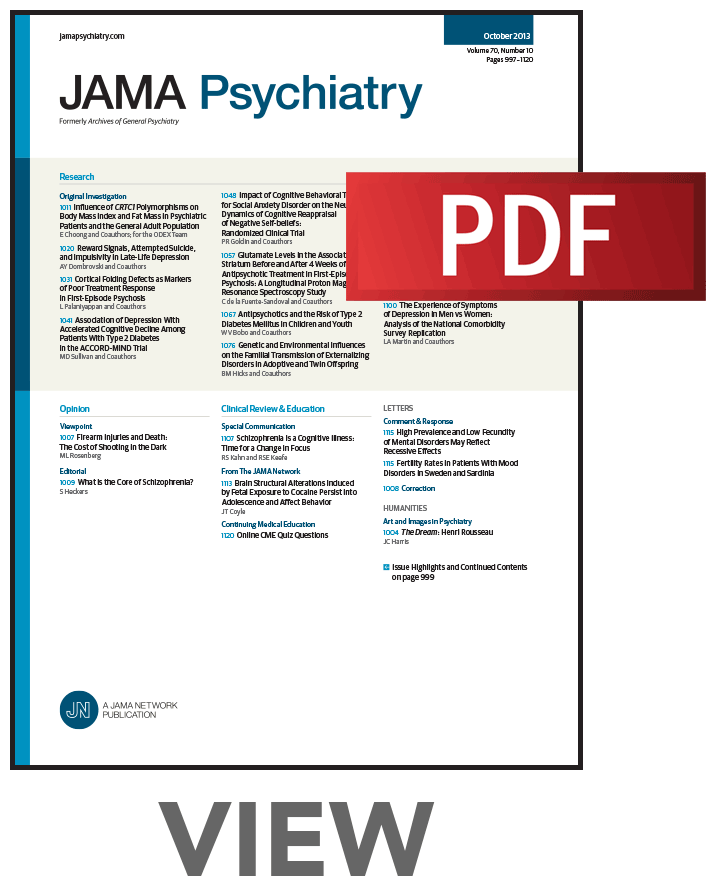一般智力和酒精使用障碍风险的测量。
IF 17.1
1区 医学
Q1 PSYCHIATRY
引用次数: 0
摘要
一般智力(IQ)、受教育程度(EA)和酒精使用障碍(AUD)之间的关系尚不清楚。目的探讨智商、EA与AUD风险的关系。设计、环境和参与者在瑞典国家征兵队列中检验了智商和AUD风险之间的关系。使用孟德尔随机化(MR)分析探索潜在的因果关系,并评估认知表现的多基因评分(PGS)与AUD诊断的关联。参与者数据来自交联的瑞典国家登记册、全基因组关联研究(GWAS)汇总统计数据和美国耶鲁-宾夕法尼亚大学队列。与认知表现相关的暴露智商和基因变异。主要结局和测量AUD的风险比(hr)或优势比(ORs)。结果本研究纳入了瑞典征兵登记册中1950年至1962年间出生的645 488名男性的全国队列,其中573 855人被纳入本分析。所有受试者的智商均为18岁,在征兵时无物质使用障碍诊断,平均(SD)随访时间(SD)为60.5(7.9)年。以FinnGen AUD GWAS作为复制样本(总数= 500 348;病例= 20 597),对欧洲样遗传血统(EUR)个体的认知表现GWAS (n = 257 481)和AUD(总数= 753 248;病例= 113 325)的汇总统计数据进行MR分析。PGS分析使用来自耶鲁-宾夕法尼亚大学队列的EUR个体数据(n = 5424)。瑞典男性18岁时的智商与AUD风险呈负相关(校正HR, 1.43; 95% CI, 1.40-1.47; P <。001),调整了父母物质使用障碍、先证者精神障碍、社会经济因素和出生年份。MR分析显示认知能力低下与AUD风险之间存在因果关系(β [SE], 0.11 [0.02]; P = 2.6 × 10-12)。环境评估的中介作用因国家背景而异。在耶鲁-宾夕法尼亚大学的参与者中,较高的认知能力PGS与较低的AUD几率相关(OR, 0.83; 95% CI, 0.78-0.89)。智商和认知表现与AUD风险有显著但依赖于情境的关联,这突出了更好地理解遗传因素、认知特征和社会文化对AUD易感性的影响之间的相互作用的必要性。本文章由计算机程序翻译,如有差异,请以英文原文为准。
Measures of General Intelligence and Risk for Alcohol Use Disorder.
Importance
Associations among general intelligence (IQ), educational attainment (EA), and alcohol use disorder (AUD) are not well understood.
Objective
To examine the relationship between IQ, EA, and AUD risk.
Design, Setting, and Participants
The association between IQ and AUD risk was examined in a Swedish national conscription cohort. Potential causality was explored using mendelian randomization (MR) analyses, and the association of polygenic scores (PGS) for cognitive performance with AUD diagnosis was assessed. Participant data were obtained from cross-linked Swedish national registers, genome-wide association study (GWAS) summary statistics, and the US Yale-Penn cohort.
Exposures
IQ and genetic variants associated with cognitive performance.
Main Outcomes and Measures
Hazard ratios (HRs; time-to-event analyses) or odds ratios (ORs) for AUD.
Results
Included in this study was a national cohort of 645 488 males, born between 1950 and 1962, from the Swedish Military Conscription Register, of whom 573 855 individuals were included in this analysis. All individuals were aged 18 years at IQ assessment with no substance use disorder diagnosis at conscription, and mean (SD) follow-up time (SD) was 60.5 (7.9) years. Summary statistics from GWAS of cognitive performance (n = 257 481) and AUD (total = 753 248; cases = 113 325) in individuals of European-like genetic ancestry (EUR), with FinnGen AUD GWAS as a replication sample (total = 500 348; cases = 20 597), were used for MR analyses. PGS analyses were conducted using the data of EUR individuals from the Yale-Penn cohort (n = 5424). IQ at age 18 years was inversely associated with AUD risk in Swedish males (adjusted HR, 1.43; 95% CI, 1.40-1.47; P < .001), adjusting for parental substance use disorder, probands' psychiatric disorders, socioeconomic factors, and birth year strata. MR analyses suggested a causal relationship between lower cognitive performance and AUD risk (β [SE], 0.11 [0.02]; P = 2.6 × 10-12). The mediating role of EA differed between national contexts. Higher cognitive performance PGS were associated with reduced odds of AUD in Yale-Penn participants (OR, 0.83; 95% CI, 0.78-0.89).
Conclusions and Relevance
IQ and cognitive performance have a significant but context-dependent association with AUD risk, highlighting the need for a better understanding of the interplay among genetic factors, cognitive traits, and sociocultural influences on AUD susceptibility.
求助全文
通过发布文献求助,成功后即可免费获取论文全文。
去求助
来源期刊

JAMA Psychiatry
PSYCHIATRY-
CiteScore
30.60
自引率
1.90%
发文量
233
期刊介绍:
JAMA Psychiatry is a global, peer-reviewed journal catering to clinicians, scholars, and research scientists in psychiatry, mental health, behavioral science, and related fields. The Archives of Neurology & Psychiatry originated in 1919, splitting into two journals in 1959: Archives of Neurology and Archives of General Psychiatry. In 2013, these evolved into JAMA Neurology and JAMA Psychiatry, respectively. JAMA Psychiatry is affiliated with the JAMA Network, a group of peer-reviewed medical and specialty publications.
 求助内容:
求助内容: 应助结果提醒方式:
应助结果提醒方式:


